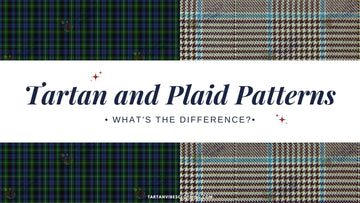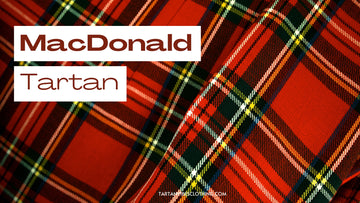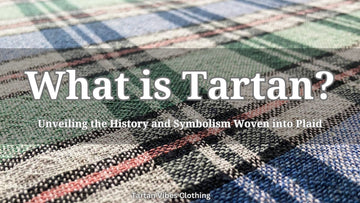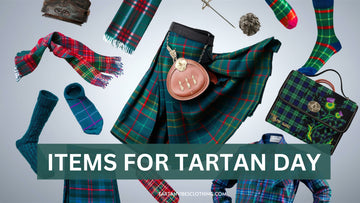Table of Content
I. Introduction
Tartan and plaid patterns are two iconic patterns that have long captured the imagination of designers, fashion enthusiasts, and cultural historians alike.
Both tartan and plaid patterns have made significant contributions to the world of fashion and design, influencing everything from clothing and accessories to interior decoration and corporate branding. This article aims to delve deeper into the differences between tartan and plaid patterns, shedding light on their unique characteristics, cultural significance, and ever-evolving role in contemporary style.
II. Confusion between the two concepts of tartan and plaid patterns

Tartan and plaid patterns feature intersecting horizontal and vertical lines at 90-degree angles. In the UK, plaid refers to a colorful pattern with intersecting lines. While Americans use the term "tartan" it should specifically denote the plaid linked to a clan. Essentially, all tartans are plaids, but not all plaids qualify as tartans.
The consistent line pattern on tartan remains the same throughout the fabric's length, known as the “sett” pattern, typically repeating every 56 inches. In contrast, plaids may lack a defined sett pattern and do not necessarily require one.
On the other hand, for tartans, the sett pattern is crucial for distinguishing between different designs. The key distinction for Americans to remember between tartan and plaid patterns is that tartan signifies a clan association, whereas plaid does not have ties to any historical clan.
An example of plaid is Gingham, characterized by two interwoven colors but lacking a connection to a specific clan or family. The MacDonald Tartan has three alternating colors (red, green, and yellow) affiliated with Clan MacDonald.
Furthermore, all tartans are officially registered with the Scottish Tartan Authority and can even be custom-designed through their service. Registering a tartan involves linking it to a clan, family, or organization, a step not taken with plaid patterns.
III. Differences in the origins and histories of tartan and plaid patterns
Tartan and plaid patterns both emerged within distinct historical contexts, reflecting the unique social and cultural landscapes of their respective origins.

Tartan, rooted in Scottish Highland culture, developed as a symbol of clan identity. Originating in the rugged terrain of the Highlands, tartan served practical purposes such as warmth and camouflage for the clansmen while also signifying allegiance to a specific clan or family. These distinct motifs are often recorded in historical records or digital archives as family tartans.
On the other hand, the plaid pattern has its origins in the Scottish Gaelic. It refers to a woven design in which colored threads intersect horizontally and vertically. The term "plaid" includes any type of woven pattern that crisscrosses different fabrics, such as felt, wool, or cotton. Initially worn as a large shawl or cloak, plaid served as versatile outerwear for both men and women, protecting the elements in the harsh Irish climate.
For instance, while your buffalo plaid pajamas feature a plaid pattern, Jamie's kilt in Outlander is distinctively tartan, as it is associated with Clan Fraser.
While both tartan and plaid patterns share similarities in their utility and association with Celtic heritage, they arose within distinct cultural milieus, each reflecting the unique traditions and historical circumstances of their respective regions.
IV. Design Traits of Tartan and Plaid Patterns
A. Tartan
What is a tartan?
Tartan is characterized by its structured grid pattern, typically featuring multiple colors woven together in intricate arrangements. This pattern is formed by intersecting horizontal and vertical stripes, resulting in a visually striking motif that is synonymous with Scottish heritage.
You can learn more about Tartan with this article: What is a Tartan? Unveiling the History and Symbolism Woven into Plaid

Types of Tartans:
- The Royal Stewart Tartan represents royalty and prestige with its bold red base and colorful bands, symbolizing the Stewart dynasty's regal heritage. Originating in the 19th century, it is now a symbol of Scottish pride worn by both royals and commoners, making it an iconic tartan in Scotland.
- Black Watch Tartan, also called the Government Tartan, features a bold design of dark blue and green with black and red lines. Originating from the uniforms of the Black Watch regiment in the 18th century, this tartan symbolizes Scottish military heritage and is proudly worn by veterans and their families.
- The MacLeod Tartan symbolizes the clan's resilience and heritage, with blue and green shades mirroring the Scottish Highlands. Dating back centuries, it embodies the traditions and values of the MacLeod clan and is a cherished emblem of their identity.
- The MacKenzie Tartan symbolizes the clan's rich history and unity with its vibrant red and green hues, mirroring Scotland's lush landscapes. Worn proudly by generations, it represents resilience and heritage at events ranging from battles to Highland gatherings.
- The Campbell Tartan represents the Campbell clan's strength and heritage. Its blue tones signify loyalty, with hints of green and black honoring their Scottish roots. Worn for over 700 years by Campbell warriors, chiefs, and leaders, it proudly reflects their lasting legacy.
- The Gordon Tartan symbolizes the clan's rich history and strength with its bold red, green, and yellow colors. Linked to Aberdeenshire's landscapes, it represents generations of Gordons' spirit and resilience.
- The Buchanan Tartan symbolizes the clan's heritage and resilience with its black and yellow pattern, reflecting their heraldic symbols from ancient times.
- The MacDonald Tartan symbolizes the clan's rich history and Scottish pride with its red, green, and yellow colors reflecting Highland landscapes. Dating back over a thousand years, it represents the clan's independence and heritage.
- The Douglas Tartan symbolizes the noble lineage and strength of the Douglas clan. Its red, green, and black design represents the clan's symbols and rich history. Worn by generations, it stands as a testament to their lasting legacy, from medieval battles to Edinburgh's power halls.
- The Fraser Tartan symbolizes the clan's strength and heritage with its red, green, and blue colors. Worn for centuries by Fraser warriors and chiefs, it represents their loyalty to Scotland.
Discover the timeless elegance of tartan with our exquisite range of products.
B. Plaid Pattern
What is a Plaid Pattern?
Plaid patterns are simpler, consisting of repeating horizontal and vertical stripes, often in a more limited color palette. These stripes can vary in width and arrangement but generally create a more straightforward, uniform design compared to tartan. Visual examples can effectively illustrate these differences, showcasing the intricate and varied patterns of tartan alongside the more straightforward layout of plaid, thereby highlighting the unique design elements of each pattern.
You can learn more about Plaid Patterns with this article: Types of Plaid Patterns: From Classic to Contemporary

Types of Plaid Patterns:
- Buffalo Check/Plaid is a popular North American plaid design with a symmetrical red and black pattern. It was originally used for blankets and jackets by lumberjacks and hunters.
- Glen Plaids are a unique plaid pattern with delicate intersecting lines, known for their asymmetrical design. Named after Prince Edward VIII, it's also called the Prince of Wales plaid. Often used in making suits, trousers, and curtains.
- Houndstooth is a bold geometric pattern with jagged lines, often in black and white. It's popular in men's suits and women's clothing like skirts and blouses. Originating around 300 BC, it's linked to both Swedish and Scottish history, resembling a dog bite. Smaller versions are sometimes called "puppytooth".
- Tattersall is a classic pattern with thin, evenly spaced stripes forming a checkered design. It's often seen on men's clothing like shirts, jackets, ties, and socks in muted colors like beige, gray, or blue. Ideal for a subtle and sophisticated look.
- Gingham is a classic checkered design with evenly sized stripes in vibrant colors like red, blue, or green. It's often linked to summer and used in clothing like dresses and shirts, as well as in home decor such as tablecloths and curtains. This pattern adds a pop of color to your wardrobe or living area. Plaid patterns, from traditional Scottish tartans to bold buffalo checks, are popular in clothing and accessories like jackets, coats, shoes, and hats.
- Modern plaids have come a long way from their origins in 16th-century Scotland. Today, they are popular in clothing and home decor, ranging from sweaters to bedding to upholstery, playing a key role in fashion and interior design.
- Windowpane plaids are a popular plaid design with a large grid pattern, often found in well-tailored clothing like suits and blazers. Named for its resemblance to a windowpane, this pattern is also seen in sweaters and vests made of wool or cotton, perfect for layering in cold weather.
- Madras plaids, originating in India, feature vibrant designs ideal for warm-weather wear. Made from light cotton, they are popular for beach outfits and casual summer dresses. Beyond clothing, Madras plaids are used in home decor like bedding and furniture, adding a playful touch with their mix of patterns and colors.
V. Differences in how tartan and plaid patterns are used
Tartan and plaid patterns hold a rich history and have been embraced across a spectrum of traditional and contemporary contexts.

Tartan, with its roots deeply embedded in Scottish culture, has served as a symbol of clan identity and cultural heritage for centuries. Primarily associated with traditional Scottish attire like kilts, tartan is not just a fabric pattern but a representation of lineage and tradition. Its presence extends to ceremonial wear, where tartan sashes and scarves are donned during special occasions, further emphasizing its significance in commemorating heritage.
In the modern era, tartan has transcended its traditional confines and made a notable impact in the realms of fashion, interior design, and accessories. Its incorporation into contemporary clothing lines, home decor items, and upholstery signifies a blend of historical charm and sophistication. By infusing pieces with tartan motifs, designers add a touch of classic elegance and cultural depth to their creations, appealing to individuals seeking a connection to tradition within a modern context.
Conversely, plaid stands out for its remarkable versatility and adaptability. This timeless pattern finds its way into a diverse array of fashion pieces, from shirts and dresses to coats and skirts, showcasing its enduring popularity and ability to remain relevant through changing trends. Beyond the fashion industry, plaid's appeal extends to home decor, where it adorns textiles like blankets, curtains, and rugs, as well as being featured in stationery, packaging, and corporate branding efforts. The adaptability of plaid allows it to seamlessly integrate into various facets of everyday life, injecting spaces with warmth, style, and individuality, whether in personal or professional settings.
VI. Conclusion
In conclusion, while tartan and plaid patterns may appear similar at first glance, they carry distinct historical origins and cultural associations. Tartan, deeply rooted in Scottish Highland heritage, symbolizes clan identity, affiliation, and regional pride, serving as a hallmark of Scottish culture. In contrast, plaid originally referred to a type of garment in Gaelic-speaking regions of Ireland and later came to describe any fabric with a striped or checked pattern. Despite some overlap in terminology, tartan and plaid patterns retain unique meanings and cultural significance.
Understanding the differences between these two textile traditions illuminates the rich tapestry of Celtic heritage and highlights the diversity of cultural expressions across different regions and communities. Whether adorned in tartan kilts or cozy plaid blankets, both serve as enduring symbols of tradition, identity, and heritage for generations to come.
Frequently Asked Questions
Why do Americans say plaid instead of tartan?
Plaid is used in the UK to describe a multi-colored, cross-lined pattern. Americans do use the word tartan, but when they do, it should be to describe the plaid associated with a clan. So to complicate matters, all tartans are plaids, but not all plaids can be tartans.
Which countries wear tartans?
Although not a traditional component of national dress outside Scotland or Ireland, kilts have recently become popular in other Celtic nations as a sign of Celtic identity. Kilts and tartans can therefore also be seen in Wales, Cornwall, the Isle of Man, Brittany, and Galicia.
What are some examples of tartan and plaid patterns?
Examples of tartan patterns include the Black Watch tartan, the Royal Stewart tartan, and the Dress Gordon tartan. Plaid patterns can range from simple checkered designs to more intricate striped patterns, with variations in color and scale.
Where can I find tartan or plaid products?
Tartan and plaid patterns are widely available in stores and online, with a variety of garments, accessories, and home decor items featuring these patterns. Additionally, many Scottish heritage shops and online retailers specialize in authentic tartan products tied to specific clans and families such as tartanvibesclothing.com
How are tartan and plaid used today?
Tartan continues to be worn as kilts, scarves, and other garments, serving as symbols of tradition, identity, and heritage in Scottish culture. Plaid fabrics are commonly used in clothing, accessories, and home decor, offering a timeless and versatile pattern for a variety of applications.





